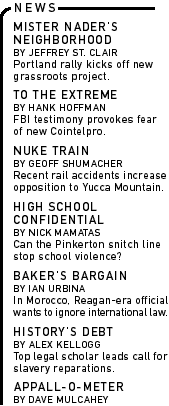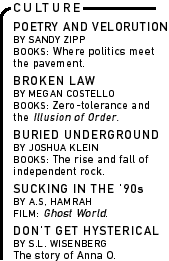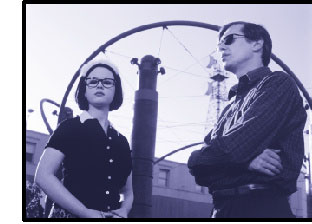|
|

|

|

|
|
|
| |
|
|
|
Ghost World Is it too soon or too late to mourn the '90s? That's a question the combination of Terry Zwigoff, the documentary filmmaker who made Crumb, and Daniel Clowes, whose comic book they adapted together, forces us to ask. In 2001, Ghost World comes off like a meditation on Clowes's acerbic, poignant series just as much as a reflection on contemporary life. Clowes's mid-'90s work was a high-water mark of Clinton-era American culture; so was Zwigoff's film on the cartoonist Robert Crumb. Together they've made a film that moves comfortably between the Crumb-Zwigoff prewar aesthetic and Clowes's postwar one. In some ways, the film is a history of how cartoonists and filmmakers have saved the things they love from a culture that insists everything is disposable, especially comics. But it's the tension, not the sympathy, between Clowes and Zwigoff--expressed in the attraction-repulsion felt by their cinematic stand-ins Enid (Thora Birch) and Seymour (Steve Buscemi)--that makes the movie work. When the pair sit silently listening to music, the filmmakers' arguments with the world recede into a repose only record-listening scenes have the privilege of creating in the movies. Ghost World starts with the alienated teen-ager Enid, dancing in her bedroom to a
Enid's disaffection protects her from people who can't understand her attachment to a different world, an exciting world of possibility freed from this one's stupidity, a world she glimpses in artifacts like the scene from Gumnaam. When she shimmies in her room to the music of Mohammad Rafi (not to be confused with just-plain Raffi, the saccharine troubadour of contemporary American childhood) she thrusts her arms out in imitation of the glamorous Indian actress on TV, a screen idol more suited to Enid's personality than the music-video stars her peers might ape. It's a moment of familiar adolescent solitude, even if it's played against a movie that looks like something Paramount would've made if they'd signed Little Richard instead of Elvis and allowed Deborah Walley to throw herself around with more abandon. (Similarly, when Enid dons a bondage mask she recalls Yvonne Craig, Batgirl from the '60s Batman TV series, another refugee from an Elvis musical.) If Enid longs for a world different from the one she inhabits, it's partly because she's stuck in a life that offers her little more than a job at a cineplex concession stand where upsizing by the gallon is mandatory. Even art isn't an escape for Enid, who likes to draw in a sketchbook she carries with her. (The sketches are by Sophie Crumb, teen-age daughter of cartoonists Robert and Aline.) The remedial art course she's forced to take in the summer so she can fully graduate from high school (and into her adult life) comes with an instructor (Illeana Douglas) wed to the kind of lamely politicized postmodernism that makes everyone gag but the most eager-to-please. Enid, like they used to say in Marvel comics, is trapped in a world she never made. Enid and her deadpan best friend Rebecca (Scarlett Johansson) spend their summer days parked in places such as a restaurant that Enid describes as "the Taj Mahal of fake '50s diners." Even when she's groping for something to love about her working-class milieu, Enid expresses a subconscious longing for the East. Maybe that's because her creators are enamored of a film made around the same time as Gumnaam, a charming Peter Sellers comedy called The World of Henry Orient. Enid even has a poster for it in her room. It's a movie about two teen-age girls who are obsessed with an older man--the Sellers character of the title, a goofy pianist--and how by shadowing him through New York they learn that the adult world is more compromised, but also stranger and more enchanting, than they'd imagined. Ghost World's plot follows Henry Orient's: After Enid and Rebecca play a cruel practical joke on Seymour, a lovelorn collector of old 78s, Enid begins to hang out with him. She tells herself she's doing it so she can help him negotiate a life in which he's floundering. Zwigoff's movie isn't as wistful as its cinematic predecessor; Henry Orient's world no longer exists. Ghost World moves the plot from magical to haunted, from Peter Sellers '60s to Dan Clowes '90s. The romantic artist figure Sellers played was a joke in 1964, but here even the idea of such a figure being any kind of artist at all is buried. Buscemi's Seymour isn't a musician, he's a music collector. He spends his days working in corporate management for a chain of restaurants that started its existence in the 1920s under the name "Coon Chicken Inn" and, in a more sensitive era, has evolved into Cook's Chicken. Enid knows that the world she longs for, a world that produced the kind of Skip James blues records Seymour collects and Enid listens to over and over again, wasn't any more fair or honorable than today's. When she uses an old poster for the Coon Chicken Inn as the basis for a desultory art-class project, she's punished for it after a brief flush of unexpected success. The poster was a gesture meant to provoke, but it capitulates to her art teacher's worldview. Enid's cop-out pisses people off, but it doesn't get her anywhere. Although she proves she's smarter than everyone else, by the end of the film she's forced to see that's not enough. It's a difficult position, and Ghost World wisely leaves it unresolved at the film's end. By cutting the last line of the comic book, Zwigoff brings the film to a close visually and silently. When Enid gets on a bus to nowhere, a bus reminiscent of the one on the sleeve for the Sex Pistols' "Pretty Vacant" single, her exit doesn't seem heavy or symbolic, just inevitable. Thinking of the Sex Pistols makes sense; Ghost World is animated by a tension between Seymour's 78 rpm universe and Enid's dedication to a punk ethos no one in the film can understand as anything other than a dubious fashion choice. After she dyes her hair green, Enid is again forced to defend her longing as nothing more than a gesture. She listens to the Buzzcocks alone in her room, the volume blotting her dialogue like it would in real life but rarely does in the movies. Clowes has admitted that for him late '70s punk is the last worthwhile cultural moment. When it seeps into the film, Ghost World separates itself from the heaviness defined by the dark-wood of Seymour's apartment, where the glow of authenticity is sometimes a little too comforting. It's a men's club separate from the world Enid really lives in, and when she does something to change it, her actions are foolish but necessary. In Buscemi's Seymour, Zwigoff has created a character who wears the director's heart on his sleeve. Buscemi, whose performance is as self-effacing and involving as it should be, channels the Crumbian discomfort from Zwigoff's previous feature. Ghost World is full of sentiments absent from other films.
When Seymour announces that he hates sports, or when the love of
reggae is hilariously dismissed out of hand as a sign of chumpdom,
the film shows that it's decidedly in a different camp from other
movies about teen life. The only other film it has much in common
with is Dan Zukovic's amazing, under-seen The Last Big Thing
(1996)--the two films share video-store scenes that expose the frustration
inherent in wandering aisles searching for something that's been
banished. That movie was an unexpected blast of invective at '90s
culture; Ghost World, which sets Enid adrift in the 21st
century after cataloguing the last decade's vexations, seems like
an elegy for it. A.S. Hamrah writes for Hermenaut and frequently contributed to Suck.com. He can be reached at hamrah@hermenaut.com.
|






